 W
WThe ʻakekeʻe is a bird species in the family Fringillidae, where it is placed in the Hawaiian honeycreeper genus Loxops. It is endemic to the island of Kauaʻi where it is found in small numbers in higher elevations. Because of their similar size, shape, and unusual bill, the ʻakekeʻe and the ʻakepa were for some time classified as a single species. This was eventually changed, because of differences in their color, nesting behavior, and calls.
 W
WThe Kauai ʻakialoa was a Hawaiian honeycreeper in the subfamily Carduelinae of the family Fringillidae. It was endemic to the island of Kauai, Hawaii. It became extinct in the 20th century due to introduced avian disease and habitat loss. The Kauai ʻakialoa was about seven and a half inches in length and had a very long downcurved bill, which covered one third of its length. The adult males were bright olive-yellow on top and yellow on the bottom. The throat, breast, and sides of the body were olive-yellow. The females, however, were green-gray above and had a shorter bill.
 W
WThe lesser ʻakialoa was a species of finch in the family Fringillidae. It was endemic to the island of Hawaii. It became extinct due to habitat loss. It disappeared at around the same time as its Oahu cousin.
 W
WThe Maui Nui 'akialoa or Lana'i 'akialoa was a Hawaiian honeycreeper of the subfamily Carduelinae and the family Fringillidae. It was endemic to the island of Lanai, Hawaii in modern times, but seems to have occurred on all major islands of former Maui Nui before human settlement.
 W
WThe Oʻahu ʻakialoa was a Hawaiian honeycreeper in the subfamily Carduelinae of the family Fringillidae (finches). It was formerly considered a subspecies in the greater akialoa complex before being elevated to a full species. It was endemic to the island of Oʻahu in the Hawaiian Islands.
 W
WThe ʻākohekohe, or crested honeycreeper, is a species of Hawaiian honeycreeper. It is endemic to the island of Maui in Hawaiʻi.
 W
WThe ʻapapane is a small, crimson, species of Hawaiian honeycreeper endemic to the Hawaiian Islands. They are the most abundant and widely-distributed honeycreeper and are found on the islands of Hawaiʻi, Maui, Lānaʻi, Kauaʻi, Molokaʻi and Oʻahu.
 W
WThe Bishop's ‘ō‘ō or Molokai ‘ō‘ō is a member of the extinct genus of the ‘ō‘ōs (Moho) within the extinct family Mohoidae. It was previously regarded as member of the Australo-Pacific honeyeaters (Meliphagidae). Lionel Walter Rothschild named it after Charles Reed Bishop, the founder of the Bishop Museum.
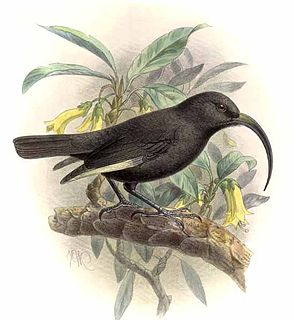 W
WThe black mamo, also known as the hoa, is an extinct species of bird once endemic to the island of Molokai; there is also subfossil evidence of it having lived on Maui.
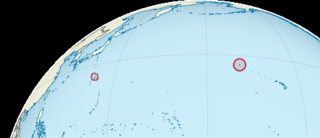 W
WBryan's shearwater is a species of shearwater that may occur around the Hawaiian Islands. It is the smallest species of shearwater and is black and white with a bluish gray beak and blue tarsi. First collected in 1963 and thought to be a little shearwater it was determined using DNA analysis to be distinct in 2011. It is rare and possibly threatened and there is little information on its breeding or non-breeding ranges. The species is named after Edwin Horace Bryan Jr. a former curator of the B. P. Bishop Museum at Honolulu.
 W
WThe Hawaiian coot, also known as the ʻalae kea in Hawaiian, is a bird in the rail family, Rallidae, that is endemic to Hawaiʻi. In Hawaiian, ʻalae is a noun and means mud hen. Kea or its synonym keo is an adjective for white. It is similar to the American coot at 33–40.6 cm (13.0–16.0 in) in length and weighing around 700 g (1.5 lb). It has black plumage and a prominent white frontal shield. Its natural habitats are freshwater lakes, freshwater marshes, coastal saline lagoons, and water storage areas. The bird was federally listed in October 1970 as an endangered species and is considered both endemic and endangered by the state of Hawaii. It is threatened by habitat loss and introduced predators such as the small Asian mongoose. The Makalawena Marsh on the Big Island of Hawaiʻi has been listed as a National Natural Landmark to preserve one of its last nesting areas.
 W
WThe ʻelepaios are three species of monarch flycatcher in the genus Chasiempis. They are endemic to the Hawaiian Islands, and were formerly considered conspecific. They measure 14 cm long and weigh 12–18 g. One species inhabits the Big Island, another Oʻahu and the third Kauaʻi. Being one of the most adaptable native birds of Hawaiʻi, no subspecies have yet become extinct, though two have become quite rare.
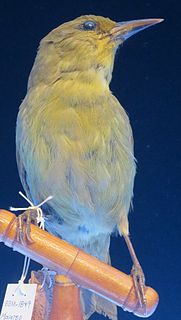 W
WThe greater ʻamakihi was a species of Hawaiian honeycreeper in the subfamily Carduelinae of the family Fringillidae.
 W
WThe greater koa finch was a species of finch in the family Fringillidae. It was found only in the Hawaiian Islands. It has been extinct since the late 19th century.
 W
WThe Hawaiʻi ʻamakihi, also known as the common ʻamakihi, is a species of Hawaiian honeycreeper.
 W
WThe Hawaiʻi ʻelepaio, also Hawaiian ʻelepaio, is a monarch flycatcher found on the Big Island of Hawaii. Until 2010, all three ʻelepaio species, the Kauaʻi ʻelepaio, the Oʻahu ʻelepaio and this species were considered conspecific.
 W
WThe Hawaiʻi mamo is an extinct species of Hawaiian honeycreeper. It was endemic to Hawaii. It became extinct due to habitat loss, mosquitoes, introduced predators such as mongoose, and over collecting.
 W
WThe Hawaiʻi ʻōʻō is a member of the extinct genus of the ʻōʻōs (Moho) within the extinct family Mohoidae. It was previously regarded as member of the Australo-Pacific honeyeaters (Meliphagidae).
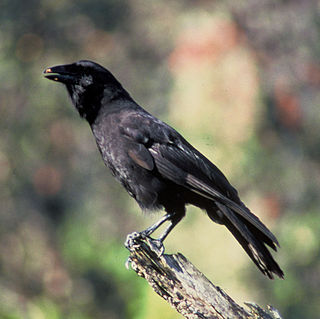 W
WThe Hawaiian crow or ʻAlalā is a species of bird in the crow family, Corvidae, that is currently extinct in the wild, though reintroduction programs are underway. It is about the size of the carrion crow at 48–50 centimetres (19–20 in) in length, but with more rounded wings and a much thicker bill. It has soft, brownish-black plumage and long, bristly throat feathers; the feet, legs and bill are black. Today, the Hawaiian crow is considered the most endangered of the family Corvidae. They are recorded to have lived up to 18 years in the wild, and 28 years in captivity. Some Native Hawaiians consider the Hawaiian crow an ʻaumakua.
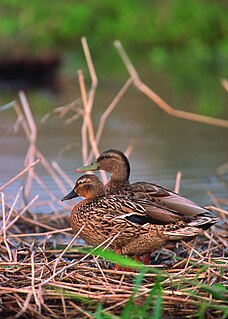 W
WThe Hawaiian duck or koloa is a species of bird in the family Anatidae that is endemic to the large islands of Hawaiʻi. Taxonomically, the koloa is closely allied with the mallard. It differs in that it is monochromatic and non-migratory. As with many duck species in the genus Anas, Hawaiian duck and mallards can interbreed and produce viable offspring, and the koloa has previously been considered an island subspecies of the mallard. However, all major authorities now consider this form to be a distinct species within the mallard complex. Recent analyses indicate that this is a distinct species that arose through ancient hybridization between mallard and Laysan duck. The native Hawaiian name for this duck is koloa maoli, or simply koloa. This species is listed as endangered by the IUCN Red List of Threatened Species, and its population trend is decreasing.
 W
WThe Hawaiian gallinule is an endangered chicken-sized water bird in the rail family. It is also variously known as the Hawaiian common gallinule, Hawaiian moorhen, Hawaiian common moorhen, mudhen, or `alae `ula in Hawaiian, and sometimes misleadingly as the Hawaiian red coot. It is a subspecies of the common gallinule that is endemic to the tropical Hawaiian Islands of the north-central Pacific Ocean.
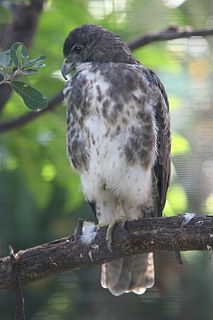 W
WThe Hawaiian hawk or ʻio is a raptor of the Buteo genus endemic to Hawaiʻi, currently restricted to the Big Island. Buteos tend to be easily recognized by their bulky bodies relative to their overall length and wingspan. The ʻio is the only hawk that is native to Hawaiʻi, and fossil evidence indicates that it inhabited the island of Hawaiʻi, Molokaʻi, Oʻahu, and Kauaʻi at one time. Today, it is known to breed only on the Big Island, in stands of native ʻōhiʻa lehua trees. The species was protected as an endangered species in the United States, but was delisted in 2020. However, the IUCN classifies the species as Near Threatened.
 W
WThe Hawaiian petrel or ʻuaʻu is a large, dark grey-brown and white petrel that is endemic to Hawaiʻi.
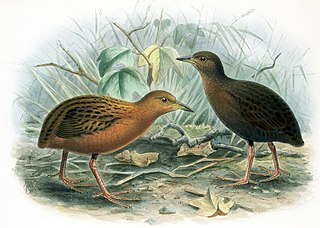 W
WThe Hawaiian rail, Hawaiian spotted rail, or Hawaiian crake is an extinct species of diminutive rail that lived on Big Island of Hawaiʻi.
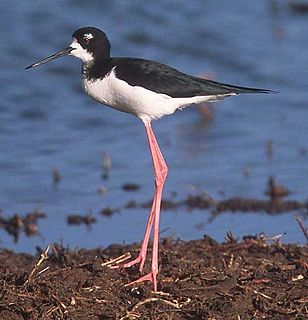 W
WThe Hawaiian stilt is an endangered Hawaiian subspecies of the black-necked stilt species. It is a long-legged, slender shorebird with a long, thin beak. Other common names include the Hawaiian black-necked stilt, the aeʻo, the kukuluaeʻo, or it may be referred to as the Hawaiian subspecies of the black-necked stilt.
 W
WThe Lānaʻi hookbill is an extinct species of Hawaiian honeycreeper. It was endemic to the island of Lānaʻi in Hawaiʻi, and was last seen in the southwestern part of the island. George C. Munro collected the only known specimen of this species in 1913, which is housed in the Bernice P. Bishop Museum in Honolulu, and saw the species only twice more, once in 1916 and for a final time in 1918. No other sightings have been reported. They inhabited montane dry forests dominated by ʻakoko and ōpuhe. The Lānaʻi hookbill was monotypic within the genus Dysmorodrepanis and had no known subspecies. Its closest relative is believed to be the ʻōʻū, and some early authors suggested that the Lānaʻi hookbill was merely a deformed ʻōʻū. The Lānaʻi hookbill was a plump, medium-sized bird with greenish olive upperparts and pale whitish yellow underparts. It also had a yellow or white superciliary line and a white chin and throat. The wings also had a distinctive and conspicuous white wing patch. The hookbill's distinguishing characteristic was its heavy, parrotlike bill, which had the mandibles hooking sharply towards each other, leaving a gap between them when the beak was closed.
 W
WLoxops is a Hawaiian honeycreeper genus in the finch family, Fringillidae. Most of them are commonly known as ʻakepa.
 W
WThe ʻiʻiwi or scarlet honeycreeper is a species of Hawaiian honeycreeper. The ʻiʻiwi is a highly recognizable symbol of Hawaiʻi. The ʻiʻiwi is the third most common native land bird in the Hawaiian Islands.
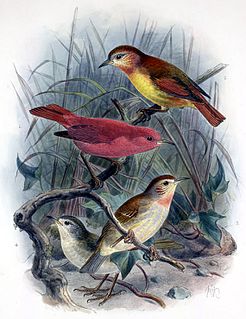 W
WThe kākāwahie or Molokaʻi creeper was a species of Hawaiian honeycreeper. It is extinct, but was found on the Hawaiian island of Molokaʻi in Hawaii.
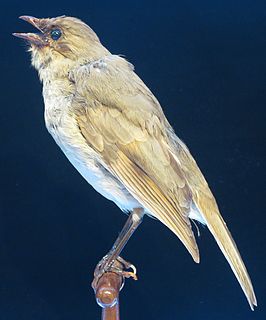 W
WThe kāmaʻo or large Kauaʻi thrush was a small, dark solitaire endemic to Kauaʻi in the Hawaiian Islands.
 W
WThe Kauaʻi ʻelepaio is a monarch flycatcher found on the Hawaiian Island of Kauai. It numbered 40,000 around 1970, but declined by half in the 1990s. Whether this fluctuation is natural and thus the birds' numbers will rebound or whether it signifies a novel threat remains to be seen. However, it seems the birds are making a recovery, as population density on the Alakai plateau has increased by 13% in recent years.
 W
WThe Kauaʻi nukupuʻu is a species of nukupuʻu once found throughout parts of the Hawaiian island of Kauaʻi. It is an insect eater that picks out its tiny prey from tree bark. The males are yellowish with brown wings, while the females are grayish brown with a yellow throat streak.
 W
WThe Kauaʻi ʻamakihi is a species of Hawaiian honeycreeper endemic to Kauaʻi. Birds of both sexes are greenish-yellow with black lores and a large, sickle-shaped, downcurved beak. The beak is larger than that of the other three ʻamakihi species and occasionally leads to misidentification as a Kauaʻi nukupuʻu, which is thought to be extinct. Like other honeycreepers, the Kauaʻi ʻamakihi is threatened by habitat loss, invasive species, and avian malaria, but has not been affected as strongly as other species in the subfamily.
 W
WThe Kauaʻi ʻōʻō or ʻōʻōʻāʻā was a member of the extinct genus of the ʻōʻōs (Moho) within the extinct family Mohoidae from the islands of Hawai'i. It was previously regarded as member of the Australo-Pacific honeyeaters. This bird was endemic to the island of Kauaʻi. It was common in the subtropical forests of the island until the early twentieth century, when its decline began. Its song was last heard in 1987, and it is now probably extinct. The causes of its extinction include the introduction of the Polynesian rat, the domestic pig, and mosquitoes, as well as habitat destruction.
 W
WThe kioea was a Hawaiian bird that became extinct around 1859. The kioea was in decline even before the discovery of Hawaiʻi by Europeans. Even native Hawaiians are seemingly unfamiliar with this bird. The feathers of the kioea were not used in Hawaiian featherwork, nor is it mentioned in any chants or legends. Only four specimens exist in museums.
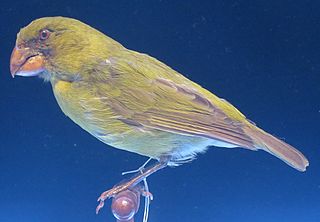 W
WThe Kona grosbeak is an extinct species of Hawaiian honeycreeper. The Kona grosbeak was endemic to naio forests on ʻaʻā lava flows at elevations of 1,400–1,500 metres (4,600–4,900 ft) near the Kona District on the island of Hawaii. The species was already very rare when it was first discovered, being found in only about 10 square kilometres (3.9 sq mi), and was last collected in 1894. Reasons for its extinction are not very well known. The genus is known from fossils from Kauai, Oahu and Maui. It was unknown to the Native Hawaiians, and thus a name for it does not exist in the Hawaiian language.
 W
WThe Laysan duck, also known as the Laysan teal, is a dabbling duck endemic to the Hawaiian Islands. Fossil evidence reveals that Laysan ducks once lived across the entire archipelago, but today survive only on Laysan Island and two atolls. The duck has several physical and behavioral traits linked to the absence of ground-based predators in its habitat. By 1860, the ducks had disappeared from everywhere except Laysan Island. The introduction of rabbits brought the bird to the brink of extinction in 1912 with twelve surviving individuals. Rabbits were eradicated from the island in 1923 and numbers of Laysan ducks began to rise, reaching 500 by the 1950s. In an effort to ensure the long-term future of this duck, 42 birds were translocated to Midway Atoll National Wildlife Refuge in 2002. These thrived in their new surroundings, and another group were later relocated to Kure Atoll.
 W
WThe Laysan finch is a species of Hawaiian honeycreeper, that is endemic to the Northwestern Hawaiian Islands. It is one of four remaining finch-billed Hawaiian honeycreepers, and is closely related to the smaller Nihoa finch. The Laysan finch is named for Laysan, the island to which it was endemic on its discovery. It was subsequently introduced to a few other atolls, and its historical range included some of the main islands.
 W
WThe Laysan millerbird was a subspecies of the millerbird, similar in appearance to the remaining subspecies, the Nihoa millerbird. Its dorsal side was brown, and its belly was grayish. Its name derives from its favorite food, several species of moths of the genus Agrotis commonly referred to as "millers".
 W
WThe Laysan rail or Laysan crake was a flightless bird endemic to the Northwest Hawaiian Island of Laysan. This small island was and still is an important seabird colony, and sustained a number of endemic species, including the rail. It became extinct due to habitat loss by domestic rabbits, and ultimately World War II.
 W
WThe lesser koa finch is an extinct species of Hawaiian honeycreeper.
 W
WThe Maui ʻakepa is a species of ʻakepa native to Maui in the Hawaiian Islands, and which was common throughout the island. Introduced mosquitoes and other animals to Maui contributed to the declining population, and the bird is considered critically endangered by the IUCN Red List of Threatened Species. The last reported sighting of this bird was in 1988, and it is possibly extinct.
 W
WThe Maui ʻalauahio, also known as the Maui Nui ʻalauahio or Maui creeper, is a species of Hawaiian honeycreeper. It is endemic to Maui Nui, Hawaii. The name Maui ʻalauahio is somewhat misleading because the species seems to have occurred on most, if not all, parts of the ancient Maui Nui, which includes the present day islands of Maui, Molokaʻi, Lānaʻi, and Kahoʻolawe. There are two subspecies: the Lānaʻi ʻalauahio, P. montana montana, which occurred on Lānaʻi (extinct); and P. montana newtoni which occurs on Maui. The common name refers to both groups.
 W
WThe Maui nukupuʻu is a species of nukupu‘u Hawaiian honeycreeper that is endemic to the island of Maui in the Hawaiian Islands. The small, five-inch-long bird lives only in eastern Maui, where it is dependent on high-elevation mesic and wet forests of ʻōhiʻa lehua and koa. These two species of trees attract insects, causing the Maui nukupuʻu to have a higher chance of finding a meal near these trees.
 W
WThe Maui parrotbill or kiwikiu is a species of Hawaiian honeycreeper, that is endemic to Maui in Hawaii. It can only be found in 50 square kilometres (19 sq mi) of mesic and wet forests at 1,200–2,150 metres (3,940–7,050 ft) on the windward slopes of Haleakalā. This species is critically endangered, with an estimated population of only 500 individuals. Fossil evidence indicates that the bird could at one time be seen in dry forests at elevations as low as 200–300 metres (660–980 ft), as well as on the island of Molokaʻi.
 W
WThe nene, also known as nēnē and Hawaiian goose, is a species of bird endemic to the Hawaiian Islands. The official bird of the state of Hawaiʻi, the nene is exclusively found in the wild on the islands of Oahu, Maui, Kauaʻi, Molokai, and Hawaiʻi.
 W
WNewell's shearwater or Hawaiian shearwater (ʻaʻo), is a seabird in the family Procellariidae. It belongs to a confusing group of shearwaters which are difficult to identify and whose classification is controversial. It was formerly treated as a subspecies of the Manx shearwater and is now often placed in Townsend's shearwater. It is endemic to the Hawaiian Islands.
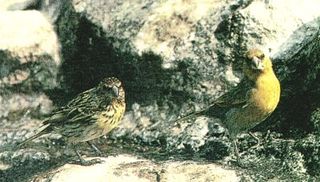 W
WThe Nihoa finch is one of the two endemic bird species of the tiny Hawaiian island Nihoa, the other being the Nihoa millerbird. When it was classified in 1917, scientists thought that it would be the last endemic species named. This was later found untrue. The island's population is 1000–3000 birds. The Nihoa finch was added to the Endangered Species List by the U.S. Fish and Wildlife Service on March 11, 1967. An attempt to protect the species against extinction was made by starting a colony on French Frigate Shoals, another leeward island. This would ensure its continued existence in the event that the Nihoa population was wiped out. This attempt, however, failed. Nihoa is part of a group of islands that make up the Hawaiian Islands National Wildlife Refuge which provides protected land for the Nihoa finch to roam on.
 W
WThe Nihoa millerbird is a subspecies of the millerbird. It gets its name from its preferred food, the Miller moth. The 5-inch (13 cm) long millerbird has dark, sepia-colored feathers, white belly, and dark beak. Its natural geographic range is limited to the tiny island of Nihoa in the Northwestern Hawaiian Islands, and it is hoped that birds translocated to Laysan will help to ensure the survival of the species. The Nihoa millerbird is one of the two endemic birds remaining on Nihoa, the other being the Nihoa finch.
 W
WThe Oʻahu ʻelepaio is a monarch flycatcher found on the Hawaiian Island of Oahu.
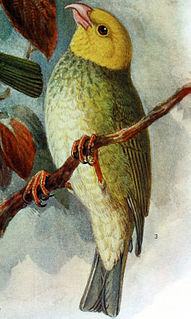 W
WThe ʻōʻū, is a species of Hawaiian honeycreeper, that is endemic to the Hawaiian islands. It has a dark green back and olive green underparts; males have a yellow head while females have a green head. Its unusual beak seems to be adapted to feeding on the fruits of Freycinetia arborea. It has a strong flight which it uses to fly considerable distances in search of this Hawaiian endemic vine, but will eat other fruits, buds, flowers and insects.
 W
WThe Oʻahu ʻamakihi is a species of Hawaiian honeycreeper in the family Fringillidae. The male is rich yellow below, sharply contrasted with greenish upper parts. Females are duller and have two prominent wing-bars. It has a total length of approximately 4.5 inches (11 cm). It is endemic to the island of Oʻahu in Hawaiʻi, and is likely the only surviving honeycreeper endemic to the island.
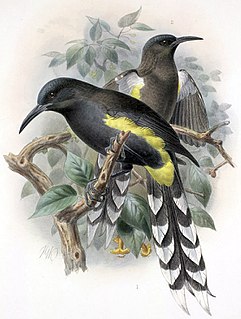 W
WThe O‘ahu ‘ō‘ō is a member of the extinct genus of the ‘ō‘ōs (Moho) within the extinct family Mohoidae. It was previously regarded as member of the Australo-Pacific honeyeaters (Meliphagidae).
 W
WThe olomaʻo is a small, dark solitaire endemic to Maui, Lānaʻi and Molokaʻi in the Hawaiian Islands. It is probably extinct. It grows up to 7 inches in length. The male and female of the species look similar. It is dark brown above and gray below with blackish legs. It is closely related to the other species of Hawaiian thrushes, the puaiohi, ʻōmaʻo, and the probably extinct kāmaʻo.
 W
WThe ʻōmaʻo is an endemic species of robin-like bird found only on the island of Hawaii. ʻŌmaʻo are closely related to the other endemic thrushes of the Hawaiian Islands, the kāmaʻo, the olomaʻo, and the puaiohi. ʻŌmaʻo are found primarily in rainforests in the eastern and southeastern regions of the Big Island. Population estimates approximate 170,000 birds, making it the most common of the Hawaiian thrushes. It appears to have a stable population, but because the entire population exists on a small range and is endemic to a single island, it is considered vulnerable.
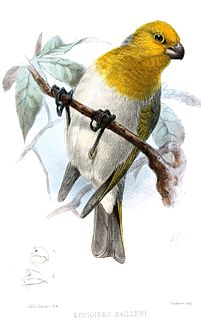 W
WThe palila is a critically endangered finch-billed species of Hawaiian honeycreeper. It has a golden-yellow head and breast, with a light belly, gray back, and greenish wings and tail. The bird has a close ecological relationship with the māmane tree, and became endangered due to destruction of the trees and accompanying dry forests. The first specimen of the palila was collected in 1876 at the Greenwell Ranch on the Big Island by Pierre Étienne Théodore Ballieu (1828–1885), who was French consul in Hawai‘i from 1869 to 1878. The type specimen is housed at the Muséum national d'histoire naturelle in Paris.
 W
WThe poʻo-uli, or black-faced honeycreeper, is an extinct species of passerine bird that was endemic to the island of Maui in Hawaiʻi. It is considered to be a member of the Hawaiian honeycreepers, and is the only member of its genus Melamprosops. It has a black head, brown upper parts and pale grey underparts. This bird inhabits only the drier, easternmost side of Maui, where it has rapidly decreased in numbers. With extinction threatening, efforts were made to capture birds to enable them to breed in captivity. This has been largely unsuccessful; in 2004, only two known birds remained, and since then, no further birds have been sighted. A 2018 study recommended declaring the species extinct, citing bird population decline patterns and the lack of any confirmed sightings since 2004, and in 2019, the species was declared extinct.
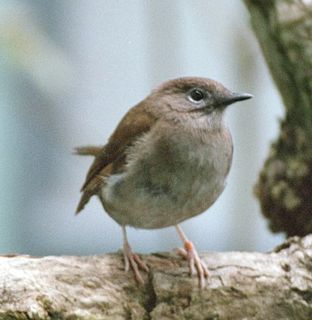 W
WThe puaiohi, or small Kauaʻi thrush, is a rare species of songbird in the thrush family, Turdidae, that is endemic to the Hawaiian island of Kauaʻi. It is closely related to the other four endemic Hawaiian thrushes, the kāmaʻo, olomaʻo, ʻōmaʻo, and ʻāmaui. It was first collected by Henry Palmer in 1891 at Halemanu around the entrance to the Kōkeʻe State Park.
 W
WThe pueo is a subspecies of the short-eared owl and is endemic to Hawaii. The pueo is one of the more famous of the various physical forms assumed by ʻaumākua in Hawaiian culture.
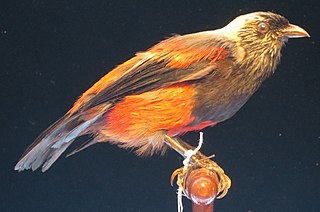 W
WThe ʻula-ʻai-hāwane was a small Hawaiian honeycreeper, now extinct. The term ʻula-ʻai-hāwane is a Hawaiian phrase translating to "red [bird] that eats hāwane". It was only ever reported from the forested mountains of the Kohala, Hilo and Kona districts on the island of Hawaiʻi. Fossil remains reveal that it also existed at one time on other Hawaiian islands. The species is named after Anna Dole, wife of Sanford B. Dole.